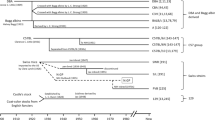Abstract
A highly fecund inbred mouse line has been established from the Quackenbush Swiss (QS) outbred strain by full-sib inbreeding combined with selection for high number of pups born alive (NBA) and low interlitter interval (ILI). After more than 50 generations of inbreeding and selection, this line, named QSi5, has an NBA of 13.4 and an ILI of 29 days, averaged over the first four parities, and a total productivity of 50.7 NBA. With its exceptional reproductive performance, this line will be very useful in the creation of resources (including advanced intercross lines) for analysis of quantitative trait loci for a wide range of traits, and for the cost-effective creation of congenic lines.





Similar content being viewed by others
References
RG Beilharz (1982) ArticleTitleThe effect of inbreeding on reproduction in mice Anim Prod 34 49–54
JC Bowman DS Falconer (1960) ArticleTitleInbreeding depression and heterosis of litter size in mice Genet Res 1 262–274
L Bünger WG Hill (1999) ArticleTitleInbred lines of mice derived from long-term divergent selection on fat content and body weight Mamm Genome 10 645–648 Occurrence Handle10.1007/s003359901063
L Bünger A Laidlaw G Bulfield EG Eisen JF Medrano et al. (2001) ArticleTitleInbred lines of mice derived from long-term growth selected lines: unique resources for mapping growth genes Mamm Genome 12 678–686 Occurrence Handle10.1007/s00335-001-3018-6 Occurrence Handle1:CAS:528:DC%2BD3MXnt1CqtL4%3D Occurrence Handle11641715
CK Chai (1966) ArticleTitleCharacteristics in inbred mouse populations plateaued by directional selection Genetics 54 743–753
B Charlesworth D Charlesworth (1999) ArticleTitleThe genetic basis of inbreeding depression Genet Res 74 329–340 Occurrence Handle10.1017/S0016672399004152
CC Cheung ICA Martin KR Zenger JR Donald PC Thomson et al. (2004) ArticleTitleQuantitative Trait Loci for steady-state platelet count in mice Mamm Genome 15 784–797 Occurrence Handle10.1007/s00335-004-2408-y
PM Corva JF Medrano (2001) ArticleTitleQuantitative trait loci (QTL) mapping for growth traits in the mouse: A review Genet Sel Evol 33 105–132 Occurrence Handle10.1051/gse:2001112
A Darvasi M Soller (1995) ArticleTitleAdvanced intercross lines, an experimental population for fine genetic mapping Genetics 141 1199–1207 Occurrence Handle1:CAS:528:DyaK28Xht1CltLs%3D Occurrence Handle8582624
DS Falconer (1971) ArticleTitleImprovement of litter size in a strain of mice at a selection limit Genet Res 17 215–235
DS Falconer (1976) Genetic aspects of breeding methods The UFAW Handbook on the Care and Management of Laboratory Animals EditionNumber5 Livingston Churchill Edinburgh 72–96
FW Festing (1993) International index of laboratory animals EditionNumber6 MFW Festing Leicester, UK 238
J Flint R Mott (2001) ArticleTitleFinding molecular basis of quantitative traits: successes and pitfalls Nat Rev Genet 2 437–445
AR Gilmour BR Cullis SJ Welham R Thompson (1999) ASREML Reference Manual, NSW Agriculture Biometric Bulletin No.3 Orange NSW Agriculture Australia 210
TS Hauschka EA Mirand (1973) The “Breeder: HA (ICR)” Swiss Mouse, a Multipurpose Stock Selected for Fecundity GP Murphy D Pressman EA Mirand (Eds) Perspectives in Cancer Research and Treatment Alan R. Liss New York 319–331
International Committee on Standardized Genetic Nomenclature for Mice (ICSGNM) (2003) Rules for nomenclature of mouse and rat strains. www.informatics.jax.org/mgihome/nomen/strains.shtml (2 July 2003)
PD Keightley (1998) ArticleTitleGenetic basis of response to 50 generations of selection on body weight in inbred mice Genetics 148 1931–1939
PD Keightley T Hardge L May G Bulfield (1996) ArticleTitleA genetic map of quantitative trait loci for body weight in the mouse Genetics 142 227–235 Occurrence Handle1:CAS:528:DyaK28Xht1Cqtrg%3D Occurrence Handle8770600
BW Kirkpatrick A Mengelt N Schulman ICA Martin (1998) ArticleTitleIdentification of quantitative trait loci for prolifacy and growth in mice Mamm Genome 9 97–102 Occurrence Handle10.1007/s003359900696 Occurrence Handle1:CAS:528:DyaK1cXhtFKktrs%3D Occurrence Handle9457667
RC Lacy G Alaks A Walsh (1996) ArticleTitleHierarchical analysis of inbreeding depression in Peromyscus polionotus Evolution 50 2187–2200
CJ Lynch (1969) ArticleTitleThe so-called Swiss mouse Lab Anim Care 19 214–220
TF Mackay JD Fry RF Lyman SV Nuzhdin (1994) ArticleTitlePolygenic mutation in Drosophila melanogaster: estimates from response to selection of inbred strains Genetics 136 937–951
JC McCarthy (1967) ArticleTitleThe effects of inbreeding on the components of litter size in mice Genet Res 10 73–80
ME Montgomery JD Ballou RK Nurthen PR England DA Briscoe et al. (1997) ArticleTitleMinimizing kinship in captive breeding programs Zoo Biol 16 377–389 Occurrence Handle10.1002/(SICI)1098-2361(1997)16:5<377::AID-ZOO1>3.0.CO;2-7
L Ollivier (1999) ArticleTitleOn the use of animal models in the analysis of selection experiments Genet Sel Evol 31 135–148
MC Rice SJ O’Brien (1980) ArticleTitleGenetic variance of laboratory outbred Swiss mice Nature 283 157–161 Occurrence Handle10.1038/283157a0
RC Roberts (1960) ArticleTitleThe effect on litter size of crossing lines of mice inbred without selection Genet Res 1 239–252
J Staats (1980) ArticleTitleStandardized nomenclature for inbred strains of mice Cancer Res 40 2083–2138
Acknowledgments
A very special thanks goes to Jennifer Kirton who was heavily involved in the early, critical generations of the breeding program. Thanks also go to Dr. Pradeepa Silva, who kindly provided background information on the derivation of the sublines, and to Zung Doan, who transferred the data into electronic form. Laboratory Animal Services, University of Sydney, arranged genotyping of the QSi5 mice for allozyme markers by Dr. Mark Adams, Evolutionary Biology Unit, SA Museum, North Terrace, Adelaide, SA, as part of routine quality control of mouse strains.
Author information
Authors and Affiliations
Corresponding author
Rights and permissions
About this article
Cite this article
Holt, M., Nicholas, F.W., James, J.W. et al. Development of a highly fecund inbred strain of mice. Mamm Genome 15, 951–959 (2004). https://doi.org/10.1007/s00335-004-3030-8
Received:
Accepted:
Issue Date:
DOI: https://doi.org/10.1007/s00335-004-3030-8




